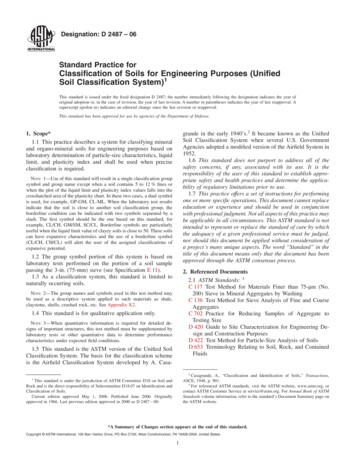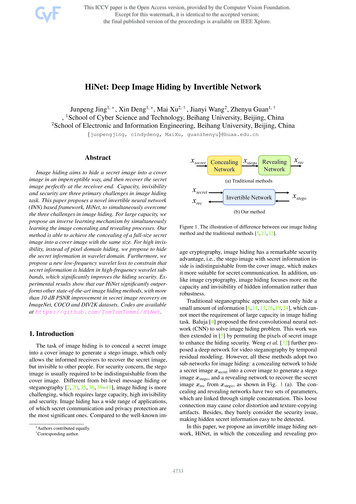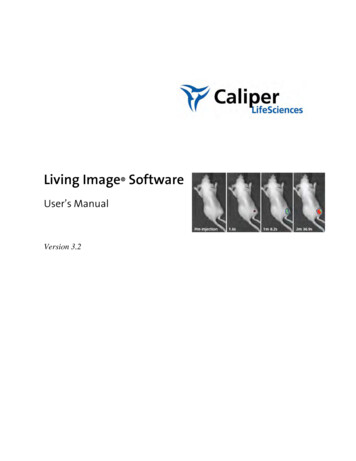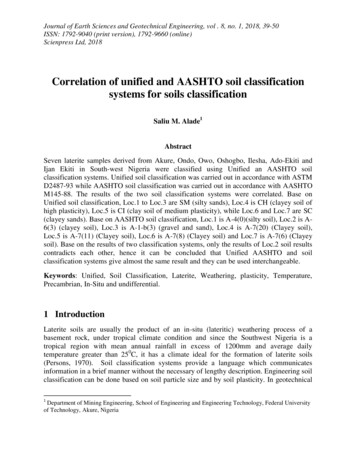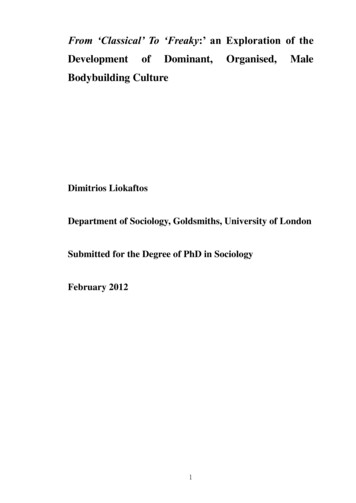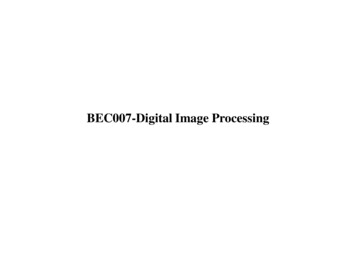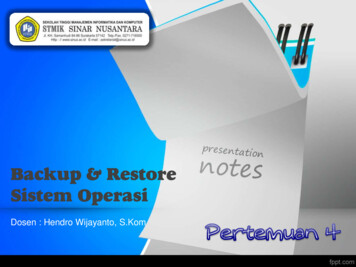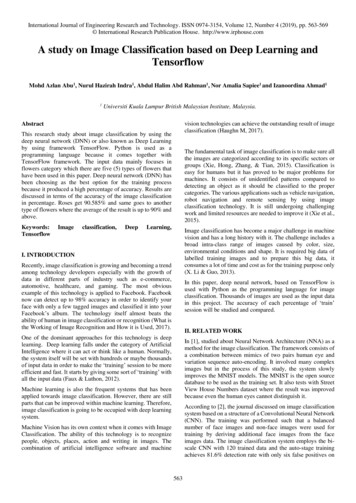
Transcription
International Journal of Engineering Research and Technology. ISSN 0974-3154, Volume 12, Number 4 (2019), pp. 563-569 International Research Publication House. http://www.irphouse.comA study on Image Classification based on Deep Learning andTensorflowMohd Azlan Abu1, Nurul Hazirah Indra1, Abdul Halim Abd Rahman1, Nor Amalia Sapiee1 and Izanoordina Ahmad11Universiti Kuala Lumpur British Malaysian Institute, Malaysia.vision technologies can achieve the outstanding result of imageclassification (Haughn M, 2017).AbstractThis research study about image classification by using thedeep neural network (DNN) or also known as Deep Learningby using framework TensorFlow. Python is used as aprogramming language because it comes together withTensorFlow framework. The input data mainly focuses inflowers category which there are five (5) types of flowers thathave been used in this paper. Deep neural network (DNN) hasbeen choosing as the best option for the training processbecause it produced a high percentage of accuracy. Results arediscussed in terms of the accuracy of the image classificationin percentage. Roses get 90.585% and same goes to anothertype of flowers where the average of the result is up to 90% epThe fundamental task of image classification is to make sure allthe images are categorized according to its specific sectors orgroups (Xie, Hong, Zhang, & Tian, 2015). Classification iseasy for humans but it has proved to be major problems formachines. It consists of unidentified patterns compared todetecting an object as it should be classified to the propercategories. The various applications such as vehicle navigation,robot navigation and remote sensing by using imageclassification technology. It is still undergoing challengingwork and limited resources are needed to improve it (Xie et al.,2015).Learning,Image classification has become a major challenge in machinevision and has a long history with it. The challenge includes abroad intra-class range of images caused by color, size,environmental conditions and shape. It is required big data oflabelled training images and to prepare this big data, itconsumes a lot of time and cost as for the training purpose only(X. Li & Guo, 2013).I. INTRODUCTIONRecently, image classification is growing and becoming a trendamong technology developers especially with the growth ofdata in different parts of industry such as e-commerce,automotive, healthcare, and gaming. The most obviousexample of this technology is applied to Facebook. Facebooknow can detect up to 98% accuracy in order to identify yourface with only a few tagged images and classified it into yourFacebook’s album. The technology itself almost beats theability of human in image classification or recognition (What isthe Working of Image Recognition and How it is Used, 2017).In this paper, deep neural network, based on TensorFlow isused with Python as the programming language for imageclassification. Thousands of images are used as the input datain this project. The accuracy of each percentage of ‘train’session will be studied and compared.II. RELATED WORKOne of the dominant approaches for this technology is deeplearning. Deep learning falls under the category of ArtificialIntelligence where it can act or think like a human. Normally,the system itself will be set with hundreds or maybe thousandsof input data in order to make the ‘training’ session to be moreefficient and fast. It starts by giving some sort of ‘training’ withall the input data (Faux & Luthon, 2012).In [1], studied about Neural Network Architecture (NNA) as amethod for the image classification. The framework consists ofa combination between mimics of two pairs human eye andvariation sequence auto-encoding. It involved many compleximages but in the process of this study, the system slowlyimproves the MNIST models. The MNIST is the open sourcedatabase to be used as the training set. It also tests with StreetView House Numbers dataset where the result was improvedbecause even the human eyes cannot distinguish it.Machine learning is also the frequent systems that has beenapplied towards image classification. However, there are stillparts that can be improved within machine learning. Therefore,image classification is going to be occupied with deep learningsystem.According to [2], the journal discussed on image classificationsystem based on a structure of a Convolutional Neural Network(CNN). The training was performed such that a balancednumber of face images and non-face images were used fortraining by deriving additional face images from the faceimages data. The image classification system employs the biscale CNN with 120 trained data and the auto-stage trainingachieves 81.6% detection rate with only six false positives onMachine Vision has its own context when it comes with ImageClassification. The ability of this technology is to recognizepeople, objects, places, action and writing in images. Thecombination of artificial intelligence software and machine563
International Journal of Engineering Research and Technology. ISSN 0974-3154, Volume 12, Number 4 (2019), pp. 563-569 International Research Publication House. http://www.irphouse.comFace Detection Data Set and Benchmark (FDDB), where thecurrent state of the art achieves about 80% detection rate with50 false positives.first one is Euclidean distance. It calculated some of the trainingsamples from the main part of spatial. The second strategy isbased on the Parzen window technique and finally, it includesspatial entropy. The result showed that two of the images havehigh resolution in terms of effectiveness of regularly.From [3] the research used Decision Tree (DT) as thetechniques in image classification. The DT has multipledatasets that are located under each of Hierarchical classifier. Itmust be done in order to calculate membership for each of theclasses. The classifier allowed some rejection of the class onthe intermediary stages. This method also required of three (3)parts which the first one is to find terminal nodes and second inthe placement of class within it. The third one is partitioning ofthe nodes. This method is considered very simple and high rateof efficiency.Based on the journal [5], it proposed fast image classificationby boosting the Fuzzy Classifiers. It was a simple way todifferentiate between known and unknown category. Thismethod is simply boosting Meta knowledge where localcharacteristic can be mostly found. It was tested with some bigdata of images and compared with the bag-of-features imagemodel. The result gave much better classification accuracy as itwas a testing process that gave a short period of time where itproduced 30% shorter compared to the previous one. Table 2shows the summary of the related works of classificationsystems.In the journal [4], this paper discusses on Support VectorMachine (SVM) active learning that was very actively growinginterests during that time. It also proposed some new idea bycombining spatial information from a sequential process in thetrial process with spectral. It requires three strategy where theTable 1. Summary of the related works of classification systemsIII. METHODBased on Figure 1, it is the framework of image classificationwhere deep neural networks are also applied. There are four (4)phases throughout this process and each of the phases will bediscussed. Each of the phases are included on TensorFlow asthe open source software and Python as its programminglanguage. Then, the process is continued to collect some of theimages (inputs), by applying DNN and lastly all images will beclassified into their groups.Fig. 1. The block diagram of Image Classification564
International Journal of Engineering Research and Technology. ISSN 0974-3154, Volume 12, Number 4 (2019), pp. 563-569 International Research Publication House. http://www.irphouse.comIII.I Training ImagesInput data for this paper mainly uses thousands of images. Allof these images are taken from ImageNet. ImageNet also wasknown as Large Scale Visual Recognition Challenge where itis a competition about detecting and classified thousands ofobject into its categories. This is an annual competition since2010 until today. This is a benchmarking or starting ofrevolution on ‘big data’.In this paper, thousands of images of flowers were obtainedthrough this ImageNet website as shown in Figure 2 and it isfree. It meant to be used by the researcher or engineers. Thisresearch paper solely focuses on classify flowers into each ofits categories. There are thousands of flower images and it hasfive types of flowers here. Each type of flowers containshundreds of images with different side and also colors. The totalnumber for all of this flower is 3670 images as shownin Table 2.Fig. 3. DNN process towards flower imagesIII.III MobileNet PerformanceIn this paper, MobileNet is used as the ‘trainer’ as it consists ofsmall efficient of deep neural networks (DNN). It has two (2)ways to configure this MobileNet which is the first one is inputimage resolution and the size of the model within MobileNet.As for this research, it was set as shown in Figure 4 where InputImage Resolution is set as 224 and Size of the model is set as0.50.Fig. 4. Script configuration of MobileNetFig. 2. The block diagram of Image ClassificationTable 2. Number of images according to the type of flowersIII.IV Flowchart of the classification systemsNo.Type of FlowersNo of r6995.Tulips799Total of flower imagesBased on Figure 5, the flowchart of image classification thatwill be implemented using TensorFlow. The programminglanguage that will be used in the software in Python. Theflowchart shows that the systems will be started by collectingimages of the flowers. After that, DNN is applied to train themodel. Running for validation or testing and if it is not theimage of a particular flower that supposedly acts as output thenit needs to start over again from DNN. The process ends afterthe output is classified into the right type of flowers.The flowchart starts with inserting sets of flower images as aninput in this research. It has five (5) types of the flower whichis Roses, Daisy, Dandelion, Sunflowers, and Tulips. After that,all of these input images undergo ‘training’ with the deep neuralnetwork (DNN).3670III.II Implementation Deep Neural Network (DNN)The deep neural network (DNN) had to train all of these sets ofdata until the systems recognize each of these 3670 images.Then, each of the classifications occurred when one of theimages being tested whether it belongs to any of these five (5)type of flowers.As shown in Figure 3, it consists of five (5) data inputs (fivetype of different flowers) and undergoes training with multiplehidden layers. The inputs are also set with fixed-size of the224x224 RGB image. The convolution process is configuredwith MobileNet as it produces an efficient convolution neuralnetworks.565
International Journal of Engineering Research and Technology. ISSN 0974-3154, Volume 12, Number 4 (2019), pp. 563-569 International Research Publication House. http://www.irphouse.comTable 3. The result of classification for Roses image inpercentageIV.II The Accuracy of the DaisyThe results for type flowers of Daisy are shown in Figure 6and Table 4. It is shown that the accuracy of the imageclassification for Daisy is 99.626% when it was simulated ]and compared to other types of flowers.Fig. 5. The flowchart of image classification systemIV. RESULTIV.I The Accuracy of the RosesThe results for type flowers of Roses are shown in Figure 6and Table 3. It is shown that the accuracy of the imageclassification for Roses is 90.585% when it was simulatedand compared to other types of flowers.Fig. 7. The result of classification for Daisy imageTable 4. The result of classification for Daisy imagein percentageFig. 6. The result of classification for Roses image566
International Journal of Engineering Research and Technology. ISSN 0974-3154, Volume 12, Number 4 (2019), pp. 563-569 International Research Publication House. http://www.irphouse.comTable 6. The result of classification for Sunflowers image inpercentageIV.III The Accuracy of the DandelionThe results for type flowers of Dandelion are shown inFigure 8 and Table 5. It is shown that the accuracy of theimage classification for Dandelion is 99.823% when it wassimulated and compared to other types of flowers.Fig. 8. The result of classification for Dandelion imageTable 5. The result of classification for DandelionIV.V The Accuracy of the Tulipsimage in percentageThe results for type flowers of Tulips are shown in Figure 10and Table 7. It is shown that the accuracy of the imageclassification for Tulips is 100.0% when it was simulated andcompared to other types of flowers.Fig. 10. The result of classification for Tulip imageIV.IV The Accuracy of the SunflowersTable 7. The result of classification for Tulip imageThe results for type flowers of Sunflowers are shown inFigure 9 and Table 6. It is shown that the accuracy of theimage classification for Sunflowers is 99.982% when it wassimulated and compared to other types of flowers.in percentageFig. 9. The result of classification for Sunflowers image567
International Journal of Engineering Research and Technology. ISSN 0974-3154, Volume 12, Number 4 (2019), pp. 563-569 International Research Publication House. http://www.irphouse.comIV.VI Comparison of two Different Size Model MobileNetVI. CONCLUSIONThis shows the graph of MobileNet with two different sizemodels. The size model was one of the parameters that can beadjusted or changed. From Figure 11, it can be seen thattraining session of MobileNet 0.50 was much faster as it onlyrequired 51 seconds while MobileNet 1.00 took more time with6 minutes 44 seconds to complete the training session.However, MobileNet 1.00 had a higher rate of accuracycompared to MobileNet 0.50. It can be concluded that as thesize of the model is bigger it is going to take more time to finishthe training session but despite that, it produces higher accuracycompared to the smaller model of MobileNet.In conclusion, this research is about image classification byusing deep learning via framework TensorFlow. It has three (3)objectives that have achieved throughout this research. Theobjectives are linked directly with conclusions because it candetermine whether all objectives are successfully achieved ornot. It can be concluded that all results that have been obtained,showed quite impressive outcomes. The deep neural network(DNN) becomes the main agenda for this research, especiallyin image classification technology. DNN technique was studiedin more details starting from assembling, training model and toclassify images into categories. The roles of epochs in DNNwas able to control accuracy and also prevent any problemssuch as overfitting. Implementation of deep learning by usingframework TensorFlow also gave good results as it is able tosimulate, train and classified with up to 90% percent ofaccuracy towards five (5) different types of flowers that havebecome a trained model. Lastly, Python have been used as theprogramming language throughout this research since it comestogether with framework TensorFlow which leads to designingof the system involved Python from start until ends.REFERENCES[1]Gregor, K., Danihelka, I., Graves, A., Rezende, D. J., &Wierstra, D. (2015). DRAW: A Recurrent .1038/nature14236[2]Rastegari, M., Ordonez, V., Redmon, J., & Farhadi, A.(2016). XNOR-net: Imagenet classification using binaryconvolutional neural networks. Lecture Notes inComputer Science (Including Subseries Lecture Notesin Artificial Intelligence and Lecture Notes rg/10.1007/978-3-319-46493-0 32[3]Kamavisdar, P., Saluja, S., & Agrawal, S. (2013). Asurvey on image classification approaches andtechniques. Nternational Journal of Advanced Researchin Computer and Communication Engineering, 017.3033.XTS7Z[4]Pasolli, E., Melgani, F., Tuia, D., Pacifici, F., & Emery,W. J. (2014). SVM active learning approach for imageclassification using spatial information. IEEETransactions on Geoscience and Remote Sensing, 3.2258676[5]Korytkowski, M., Rutkowski, L., & Scherer, R. (2016).Fast image classification by boosting fuzzy s://doi.org/10.1016/j.ins.2015.08.030[6]A. Angelova, A. Krizhevsky, and V. Vanhoucke.Pedestrian detection with a largefield- of-view deepnetwork. In Proceed- ings of ICRA, pages publications/ Angelova15LFOV.pdf.Fig. 11. Graph of 0.50 vs 1.00 MobileNetV. DISCUSSIONThe result of this paper depends on the objectives that need tobe achieved. Other than that, certain parameters also played itsroles to determine the accuracy of the image classification byusing the deep neural network (DNN).The first result of this research was tested by conductingclassification for each of the types of flowers. It can be seen allof the five (5) types of flowers showed up to 90% accuracy interms of implementation of the system of image classificationby using DNN. This happened due to the abundantly set of datathat was being used in order to train the model and of courseDNN worked excellent when there were lots of data.Then, the system was tested with an image of cow.jpg whereactually this images were not included during the trainingmodel. The images also were not one of the categories offlowers instead it fell under animals. There were some errorsafter doing the classification. The errors state that ‘Not FoundError’ which meant that the images cannot be recognized by thesystems as it was not trained so that model trained canrecognize it as an animal named as cow.Lastly, the results of the graph that showed some changes whenone of the parameters of MobileNet was changed. The size ofthe model was set into two (2) different sizes and it affected thesystems. As the size of the model become smaller, the trainingsession took short time to be completed,but the percentage ofthe accuracy might be slightly low compared to the big size ofthe training model.568
International Journal of Engineering Research and Technology. ISSN 0974-3154, Volume 12, Number 4 (2019), pp. 563-569 International Research Publication House. http://www.irphouse.com[7][8][9][10][11]Chauhan, K., & Ram, S. (2018). International Journal ofAdvanceEngineeringandResearchImageClassification with Deep Learning and Comparisonbetween Different Convolutional Neural NetworkStructures using Tensorflow and Keras, 533–538.Materials Science and Engineering, 308(1), 013Dumoulin, V., & Visin, F. (2016). A guide toconvolution arithmetic for deep learning, Kui, X., Liu, W., Xia, J., & Du, H. (2017). Research onthe improvement of python language programmingcourse teaching methods based on visualization. ICCSE2017 - 12th International Conference on s://doi.org/10.1109/ICCSE.2017.8085571Laila Ma‟ rifatul Azizah, Sitti Fadillah Umayah, SlametRiyadi, Cahya Damarjati, Nafi Ananda Utama “DeepLearning Implementation using Convolutional NeuralNetwork in Mangosteen Surface Defect Detection”,ICCSCE, ISBN 978-1-5386-3898-9, pp. 242-246, 2017Rika Sustika, Asri R. Yuliani, Efendi Zaenudin, HilmanF. Pardede “On Comparison of Deep LearningArchitectures for Distant Speech Recognition”, 2ndInternational Conferences on Information Technology,Information Systems and Electrical Engineering(ICITISEE), ISBN 978-1-5386-0659-9, pp. 17-21, 2017[12]Rui Wang, Wei Li, Runnan Qin and JinZhong Wu “BlurImage Classification based on Deep Learning”, IEEE,ISBN 978-1-5386-1621-5 pp. 1-6, 2017[13]Sachchidanand Singh, Nirmala Singh “ObjectClassification to Analyze Medical Imaging Data usingDeep Learning”, International Conference onInnovationsininformationEmbeddedandCommunication Systems (ICIIECS), ISBN 978-1-50903295-2, pp. 1-4, 2017[14]Aizat Faiz Ramli, Hafiz Basarudin, Mohd Azlan Abu,Muhyi Yaakop, Mohamad Ismail Sulaiman, FUSA:Fuzzy Logic Based Clustering Protocol for Formation ofUniform Size Clusters, 2017 International Conferenceon Engineering Technology and Technopreneurship(ICE2T), pp 1-6, 2017.[15]Bluetooth 5.0 Throughput Comparison for Internet ofThing Usability A Survey, Muhyi Yaakop, Izwan AriefAbd Malik, Zubir bin Suboh, Aizat Faiz Ramli, MohdAzlan Abu, 2017 International Conference onEngineering Technology and Technopreneurship(ICE2T), pp 1-6, 2017.[16]Sharma, M., Anuradha, J., Manne, H. K., & Kashyap, G.S. C. (2017). Facial detection using deep learning. IOPConference Series: Materials Science and 7899X/263/4/042092[17]Siregar, S. T. M., Syahputra, M. F., & Rahmat, R. F.(2018). Human face recognition using eigenface incloud computing environment. IOP Conference Series:569[18]Teny Handhayani, Janson Hendryli, Lely Hiryantyo“Comparison of Shallow and Deep Learning Models forClassification of Lasem Batik Patterns”, ICICoS, ISBN978-1-5386-0904-0, pp. 11-16, 2017[19]Ye Tao, Ming Zhang, Mark Parsons “Deep Learning inPhotovoltaic Penetration Classification”, IEEE Power &Energy Society General Meeting, ISBN 978-1-53862213-1, pp. 1-5, 2017[20]Mohd Azlan Abu, Zainudin Kornain, IzzuddinMuhammad Iqbal, Muhamad Hariz Rosli, Automatedcar braking system: Using neural network system viaLabview environment, 2012 IEEE Conference on OpenSystems, pp. 1-6, 2012[21]Mohd Azlan Abu, Muhammad Rosli Abdullah,Mohamad Yusri Yacob, Izzuddin Muhammad Iqbal,Design of Lighting Control System Using BackPropagation Learning Algorithm for Hydroponic PlantVia LABVIEW Environment, Asia Pacific Conferenceon Engineering Technopreneurship 2012, pp. 50-56,2012[22]Mohd Azlan Abu, Siti Fatimah Nordin, Mohd ZubirSuboh, Mohd Syazwan Md Yid, Aizat Faiz Ramli,Design and Development of Home Security Systemsbased on Internet of Things Via Favoriot Platform,International Journal of Applied Engineering Research,pp. 1253-1260, 2018[23]MA Abu, EMM Nasir, CR Bala, Simulation of Soil PHControl system using Fuzzy Logic Method,International Journal of Emerging Trends in ComputerImage & Processing, pp. 15-19, 2014
Machine learning is also the frequent systems that has been applied towards image classification. However, there are still parts that can be improved within machine learning. Therefore, image classification is going to be occupied with deep learning system. Machine Vision has its own context when it comes with Image Classification.

